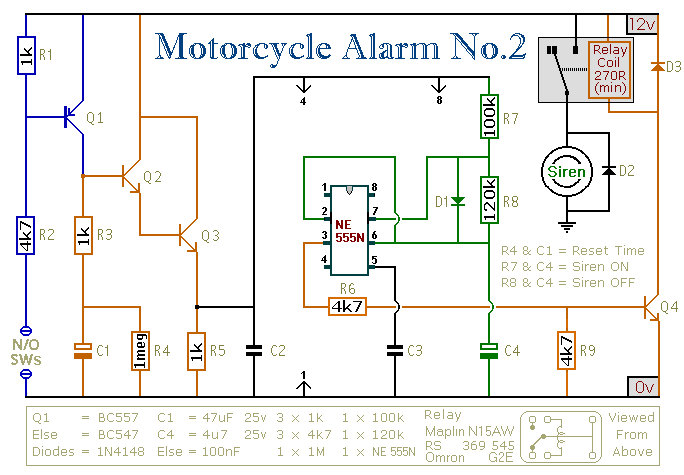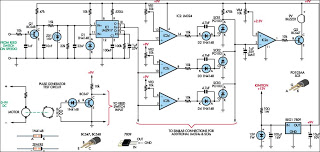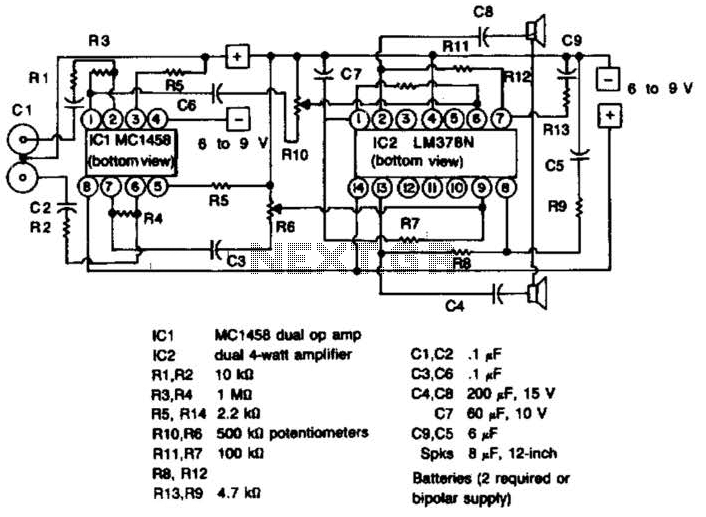
Build Your Own Motorcycle Alarm

This circuit features an intermittent siren output and automatic reset. It can be operated manually using a key switch or a hidden switch, and it can also be wired to activate automatically when the ignition is turned off. By adding external relays, functions such as immobilizing the bike or flashing the lights can be achieved. The design is based on Andy's Asymmetric Timer. Any number of normally-open switches may be utilized, including "tilt" switches that close when the steering is moved or when the bike is lifted off its side stand or pushed forward off its center stand. Micro-switches can be used to protect removable panels and the lids of panniers. The alarm's standby current is virtually zero, preventing battery drain. Once activated, the siren's on-off rate is controlled by resistors R7, R8, and capacitor C4. Increasing R7 will lengthen the sound period, while increasing R8 will extend the silent periods. The circuit is designed to operate an electronic siren drawing 300 to 400mA. It is typically not advisable to use the bike's horn due to its accessibility for disconnection; however, if the horn is chosen, a suitably rated relay must be connected to the "Siren" output to handle the necessary current. The circuit board and switches require protection from the elements, as dampness or condensation can lead to malfunctions. A 1-amp in-line fuse should be connected as close as possible to the power source for optimal protection of the wiring. The installation will vary based on the specific make of the motorcycle, limiting the ability to provide additional guidance. If one of the switches is closed when the alarm is set, the siren will sound, which may be disruptive at night. A small modification allows for monitoring the state of the switches using LEDs; when all LEDs are off, it indicates that all switches are open, making it safe to activate the alarm. The components are arranged flat on the board, while those connected between adjacent tracks are mounted upright. Bare copper wire is used for links on the component side, with two links needing to be fitted before the IC. Support material for this circuit includes a parts list, a detailed circuit description, a step-by-step construction guide, and instructions on how to test the completed alarm.
This circuit is designed to enhance security for motorcycles through an effective alarm system that combines manual and automatic activation features. The intermittent siren output serves as a deterrent against theft, while the automatic reset function ensures that the alarm does not remain activated unnecessarily. The use of normally-open switches allows for flexibility in installation, accommodating various configurations depending on the motorcycle's design.
The integration of tilt switches adds an additional layer of security, as they can detect movement or tampering with the bike's position. The use of micro-switches to protect removable components further strengthens the system, ensuring that unauthorized access triggers the alarm. The low standby current is a crucial design consideration, as it prevents battery depletion when the motorcycle is not in use, thus maintaining the vehicle's readiness.
Resistors R7 and R8, along with capacitor C4, form a timing circuit that dictates the siren's activation and silence intervals. This adjustability allows users to customize the alarm's response based on personal preference or environmental considerations. The recommendation against using the motorcycle's horn highlights the importance of using a dedicated siren, which is less likely to be disabled by potential intruders.
The circuit's resilience to environmental factors is paramount; therefore, it is essential to protect the circuit board and switches from moisture. The placement of a 1-amp fuse close to the power source is a critical safety measure, safeguarding the circuit from overcurrent situations that could damage the wiring.
The installation process requires careful attention to detail, as variations in motorcycle designs necessitate customized approaches. The ability to monitor switch states through LEDs enhances user experience, providing visual confirmation of the system's status before arming the alarm.
Overall, this alarm system represents a sophisticated approach to motorcycle security, incorporating user-friendly features and robust design elements to ensure reliability and effectiveness in protecting the vehicle. The accompanying support materials facilitate successful implementation, guiding users through each step of the construction and testing phases.This circuit features an intermittent siren output and automatic reset. It can be operated manually using a key-switch or a hidden switch; but it can also be wired to set itself automatically when you turn-off the ignition. By adding external relays you can immobilize the bike, flash the lights etc. I have used Andy`s Asymmetric Timer as the basis for this design. Any number of normally-open switches may be used. Fit "tilt" switches that close when the steering is moved or when the bike is lifted off its side-stand or pushed forward off its centre-stand. Use micro-switches to protect removable panels and the lids of panniers etc. The alarm`s standby current is virtually zero - so it won`t drain your battery. Once activated - the rate at which the siren switches on and off is controlled by R7, R8 & C4. For example, increasing R7 will make the sound period longer - while increasing R8 gives longer silent periods.
The circuit is designed to use an electronic Siren drawing 300 to 400mA. It`s not usually a good idea to use the bike`s own Horn because it can be easily located and disconnected. However - if you choose to use the Horn - remember that the alarm relay is too small to carry the necessary current.
Connect the coil of a suitably rated relay to the "Siren" output. This can then be used to sound the Horn, flash the lights etc. The circuit board and switches must be protected from the elements. Dampness or condensation will cause malfunction. Connect a 1-amp in-line fuse AS CLOSE AS POSSIBLE to your power source. This is VERY IMPORTANT. The fuse is there to protect the wiring - not the alarm. Exactly how the system is fitted will depend on the make of your particular machine - so I`m unable to provide any further help or advice in this regard. When you set the alarm - if one of the switches is closed - the siren will sound. This could cause annoyance late at night. A small modification will allow you to Monitor The State Of The Switches using LEDs. When the LEDs are all off - the switches are all open - and it`s safe to turn the alarm on. The components are all drawn lying flat on the board - but those connected between close or adjacent tracks are mounted standing upright.
The links are bare copper wire on the component side. Two of the links must be fitted before the IC. The Support Material for this circuit includes a parts list, a detailed circuit description, a step-by-step guide to construction and details of How To Test Your Finished Alarm. 🔗 External reference
This circuit is designed to enhance security for motorcycles through an effective alarm system that combines manual and automatic activation features. The intermittent siren output serves as a deterrent against theft, while the automatic reset function ensures that the alarm does not remain activated unnecessarily. The use of normally-open switches allows for flexibility in installation, accommodating various configurations depending on the motorcycle's design.
The integration of tilt switches adds an additional layer of security, as they can detect movement or tampering with the bike's position. The use of micro-switches to protect removable components further strengthens the system, ensuring that unauthorized access triggers the alarm. The low standby current is a crucial design consideration, as it prevents battery depletion when the motorcycle is not in use, thus maintaining the vehicle's readiness.
Resistors R7 and R8, along with capacitor C4, form a timing circuit that dictates the siren's activation and silence intervals. This adjustability allows users to customize the alarm's response based on personal preference or environmental considerations. The recommendation against using the motorcycle's horn highlights the importance of using a dedicated siren, which is less likely to be disabled by potential intruders.
The circuit's resilience to environmental factors is paramount; therefore, it is essential to protect the circuit board and switches from moisture. The placement of a 1-amp fuse close to the power source is a critical safety measure, safeguarding the circuit from overcurrent situations that could damage the wiring.
The installation process requires careful attention to detail, as variations in motorcycle designs necessitate customized approaches. The ability to monitor switch states through LEDs enhances user experience, providing visual confirmation of the system's status before arming the alarm.
Overall, this alarm system represents a sophisticated approach to motorcycle security, incorporating user-friendly features and robust design elements to ensure reliability and effectiveness in protecting the vehicle. The accompanying support materials facilitate successful implementation, guiding users through each step of the construction and testing phases.This circuit features an intermittent siren output and automatic reset. It can be operated manually using a key-switch or a hidden switch; but it can also be wired to set itself automatically when you turn-off the ignition. By adding external relays you can immobilize the bike, flash the lights etc. I have used Andy`s Asymmetric Timer as the basis for this design. Any number of normally-open switches may be used. Fit "tilt" switches that close when the steering is moved or when the bike is lifted off its side-stand or pushed forward off its centre-stand. Use micro-switches to protect removable panels and the lids of panniers etc. The alarm`s standby current is virtually zero - so it won`t drain your battery. Once activated - the rate at which the siren switches on and off is controlled by R7, R8 & C4. For example, increasing R7 will make the sound period longer - while increasing R8 gives longer silent periods.
The circuit is designed to use an electronic Siren drawing 300 to 400mA. It`s not usually a good idea to use the bike`s own Horn because it can be easily located and disconnected. However - if you choose to use the Horn - remember that the alarm relay is too small to carry the necessary current.
Connect the coil of a suitably rated relay to the "Siren" output. This can then be used to sound the Horn, flash the lights etc. The circuit board and switches must be protected from the elements. Dampness or condensation will cause malfunction. Connect a 1-amp in-line fuse AS CLOSE AS POSSIBLE to your power source. This is VERY IMPORTANT. The fuse is there to protect the wiring - not the alarm. Exactly how the system is fitted will depend on the make of your particular machine - so I`m unable to provide any further help or advice in this regard. When you set the alarm - if one of the switches is closed - the siren will sound. This could cause annoyance late at night. A small modification will allow you to Monitor The State Of The Switches using LEDs. When the LEDs are all off - the switches are all open - and it`s safe to turn the alarm on. The components are all drawn lying flat on the board - but those connected between close or adjacent tracks are mounted standing upright.
The links are bare copper wire on the component side. Two of the links must be fitted before the IC. The Support Material for this circuit includes a parts list, a detailed circuit description, a step-by-step guide to construction and details of How To Test Your Finished Alarm. 🔗 External reference
Warning: include(partials/cookie-banner.php): Failed to open stream: Permission denied in /var/www/html/nextgr/view-circuit.php on line 713
Warning: include(): Failed opening 'partials/cookie-banner.php' for inclusion (include_path='.:/usr/share/php') in /var/www/html/nextgr/view-circuit.php on line 713





